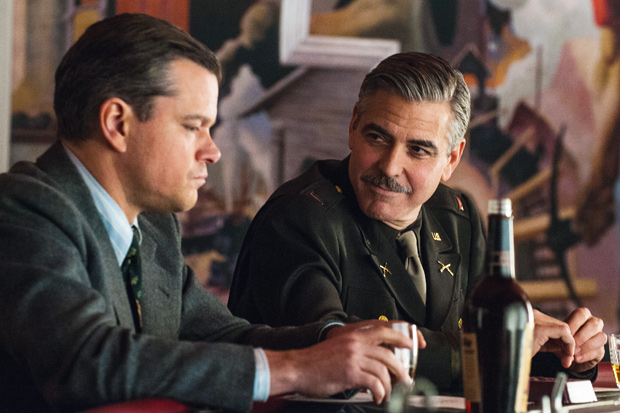You know that old quip ‘I’m not just a pretty face’? I always thought it was meant to be said tongue-in-cheek, with an undertone of self-deprecation. Surely it’s not for those literal instances when a really beautiful person does something really, really smart. It’s for when those of us on the middle-to-lower rungs of the loveliness ladder have flashes of minor inspiration. And so, ‘I’m not just a pretty face.’ Like a joke. Hahahahaha.
But what would it mean if George Clooney — ol’ salt-and-pepper-spit-curl George — said ‘I’m not just a pretty face’? The reason I ask is that he, or at least the character he’s playing, does just that in his latest film The Monuments Men. We already know that Clooney’s Frank Stokes is smart because he’s an art historian. We already know that he’s handsome because he’s played by George Clooney. But then he has to go and say it, after building a radio out of scrap: ‘I’m not just a pretty face.’ It almost frazzled my brain as I watched. But… but… George… you are a pretty face, so do you… er… mean it literally? Are you telling us that you’re super-smart as well as seriously good-looking?
Future Cloonologists may regard this as a significant moment. For more than 15 years now — since his performance in Steven Soderbergh’s Out of Sight (1998), I’d say — Clooney has been doing a lot to show us that he’s not just a pretty face, particularly by directing Confessions of a Dangerous Mind (2002) and Good Night, and Good Luck (2005). But now, with The Monuments Men, his fifth film as director, he’s telling us about it. And it’s not just that single line. The entire film is a sorry exercise in telling, not showing.
But, before we get on to that, some context. The Monuments Men is based on the real-life efforts of various academics, agents and soldiers who hurried around Europe during the second world war trying to rescue great artworks from the rubble or — worse — from Hitler’s grand designs. According to the history books, there were hundreds involved in this operation, but Clooney reduces it to a crack team of actors: himself (of course), Matt Damon, Bill Murray, John Goodman, Jean Dujardin (the French actor who, avec moustache, played the silent film star in The Artist, and, sans moustache, had some of the best scenes in The Wolf of Wall Street), Bob Balaban and Hugh Bonneville (Downton Abbey). Cate Blanchett has a slight role as a French spy, but she’s not officially one of the Monuments Men — presumably because she’s a woman.
It’s a set-up that ought to appeal to those who enjoy men-on-a-mission movies such as The Dirty Dozen (1967) and Where Eagles Dare (1968). But, really, Clooney’s film is nothing like those. Not only is the team gathered and introduced in the time it takes to roll the opening credits, but they’re also then scattered across Europe. Sometimes they’re here, sometimes they’re there. Sometimes they’re on their own, sometimes they’re together. Sometimes they’re winning, sometimes they’re losing. It’s a Patchwork War, with each soldier marching through their role in double-quick time.
And the tone of The Monuments Men is patchier still. It’s almost as though Clooney watched every second world war movie on Netflix, and tried to incorporate them all into his own. One scene has Damon mugging for laughs atop an unexploded landmine. Another, almost immediately afterwards, has him sifting through the gold teeth torn from Jewish gums. Like its director, this film wants to be pretty and smart. It also wants to be hilarious and tragic, poetic and prosaic, epic and restrained. But all of this is hurled at the screen so erratically that none of it sticks. It’s even difficult to care when two of the Men (spoiler: the two non-Americans) are killed.
Which brings us back to Clooney telling, not showing. Do you know how to be certain whether a scene in The Monuments Men is meant to be funny? The musical score will suddenly sound like the Laurel and Hardy theme. And when a scene is meant to be moving? It will have a character narrating off-camera about ‘duty’ and ‘beauty’ and ‘truth’ and all that. You cannot miss the constant shifts in tone because Clooney will not let you. War, on his account, is Tell.
And that is the greatest sin of The Monuments Men. It is undoubtedly well-meaning — an important episode in history recreated with likeable actors — but it delivers little more than one insistent cinematic cliché after another. We should bury every copy in salt-mines around Europe, and let Clooney try again.






Comments